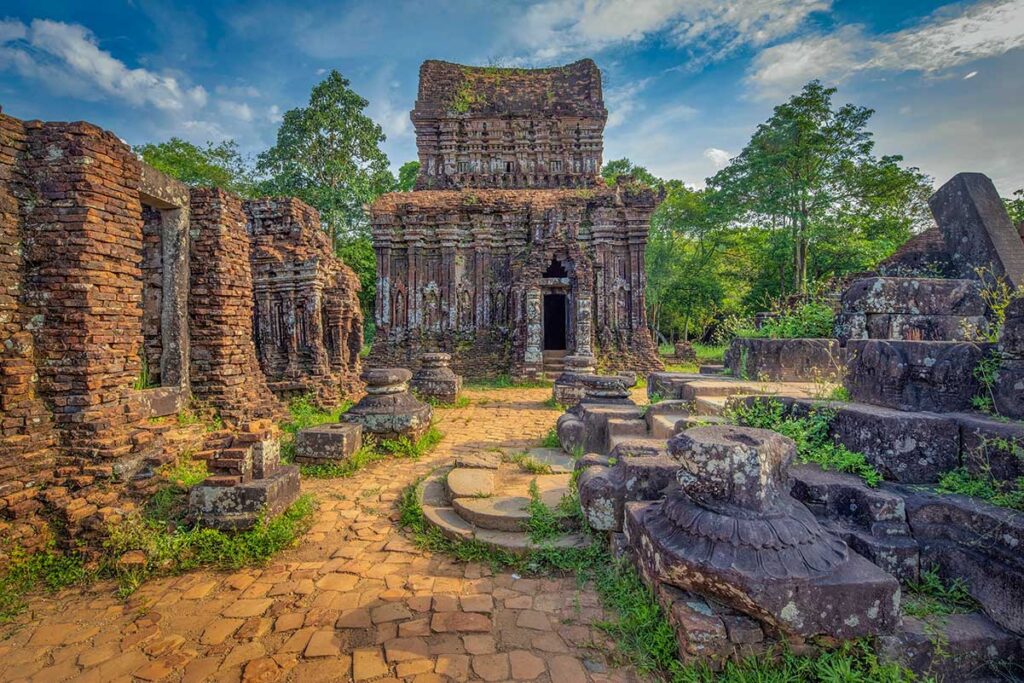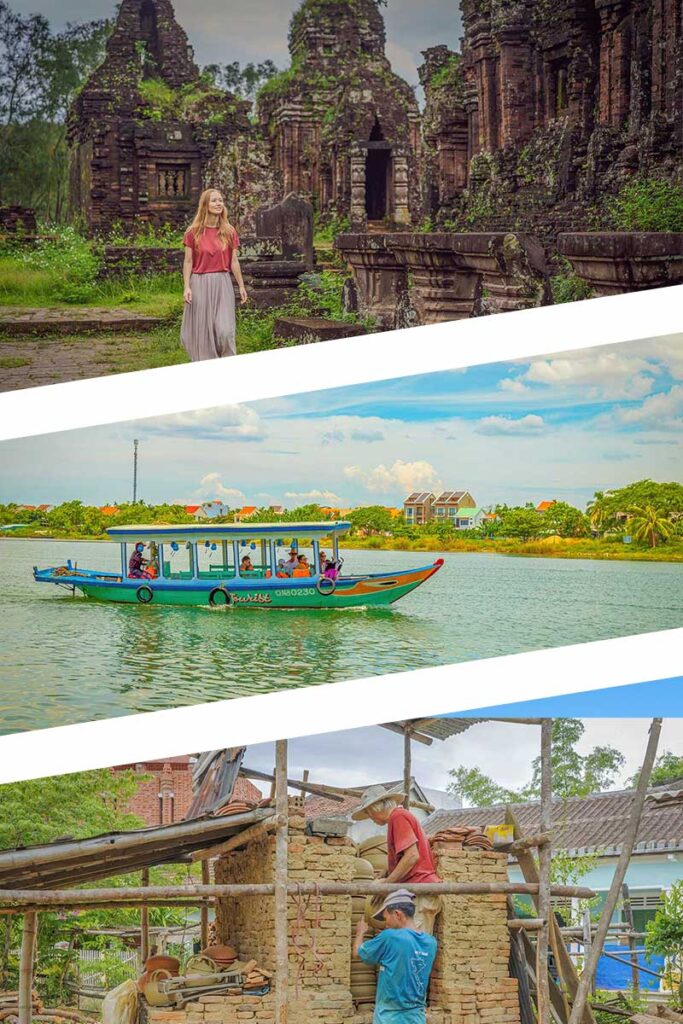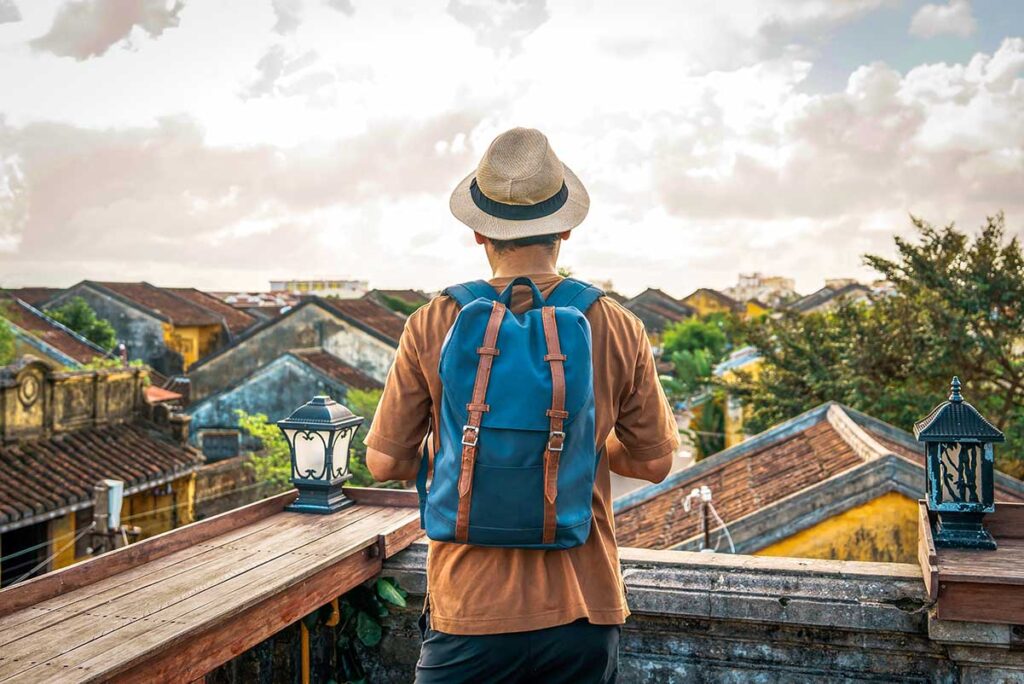What is My Son Sanctuary?
My Son Sanctuary sits deep in Central Vietnam’s countryside, about an hour inland from both Hoi An and Da Nang. It lies in a quiet, bowl-shaped valley surrounded by green hills and part of the Thu Bon River watershed, which once connected this ancient site to the sea.


The complex is a collection of red-brick Hindu temples built by the Cham people—compact, weathered, and atmospheric rather than monumental. Recognized by UNESCO for its cultural value, much of it has been carefully restored while other parts remain partly in ruins. Most travelers visit as an easy half-day trip, arriving early morning or late afternoon to enjoy the calm before the heat and tour groups arrive.
History of My Son
The Cham civilization and Hindu origins
My Son was the religious and political heart of the Cham Kingdom, which ruled central Vietnam between the 4th and 13th centuries. The Cham adopted Hinduism from India and dedicated most of their temples to Shiva. The valley was chosen to symbolize Mount Meru, the sacred home of the gods, and served as a site for royal ceremonies and burials that linked divine power with kingship.
Building and rediscovery
The temples were built over centuries from red brick and sandstone using a construction method that still impresses experts today. No visible mortar was used, yet the bricks have held together for a thousand years—possibly fused by natural resins or heat.
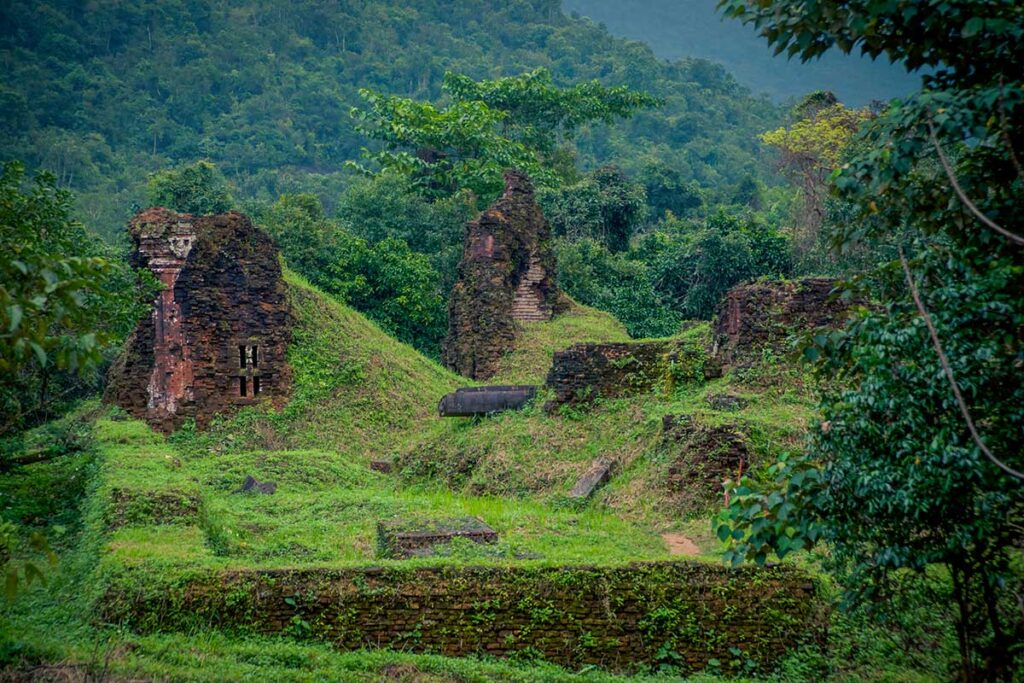
After the Cham civilization faded, the jungle reclaimed My Son until French archaeologists rediscovered it in 1898. Their maps, photographs, and restoration work helped preserve what remained and introduced Cham art and architecture to the world.
War damage and modern restoration
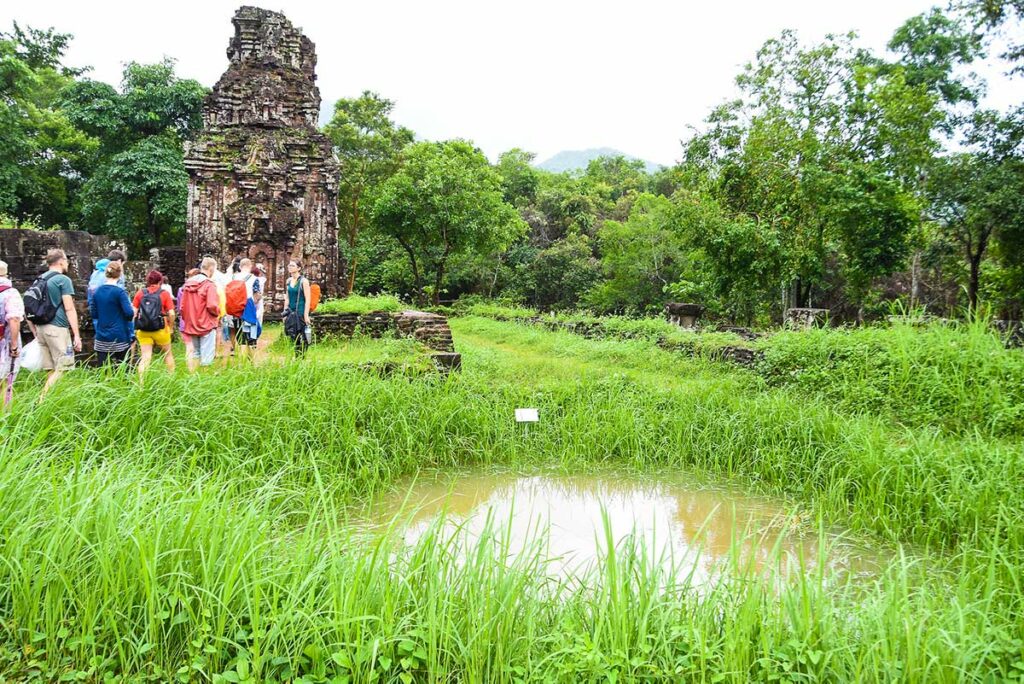
During the Vietnam War, the site was heavily bombed, and many temples were lost. Some craters are still visible, now softened by grass and lotus ponds. Despite this, several main groups survived and have been carefully stabilized by Vietnamese and international teams. Restoration continues today, so you may see scaffolding or archaeologists at work—but the ruins still keep their quiet, ancient atmosphere that makes My Son so memorable to visit.
Highlights: What to See at My Son Sanctuary
Although My Son covers a large valley, the temples themselves are concentrated in small clusters spread along a gentle walking trail. The best way to experience it is to walk slowly between the groups, taking in how each section has its own age, atmosphere, and degree of preservation. Most visitors spend around two hours here, moving from the main temple core into the quieter, more overgrown areas.
1. The Core of My Son – Groups B, C and D
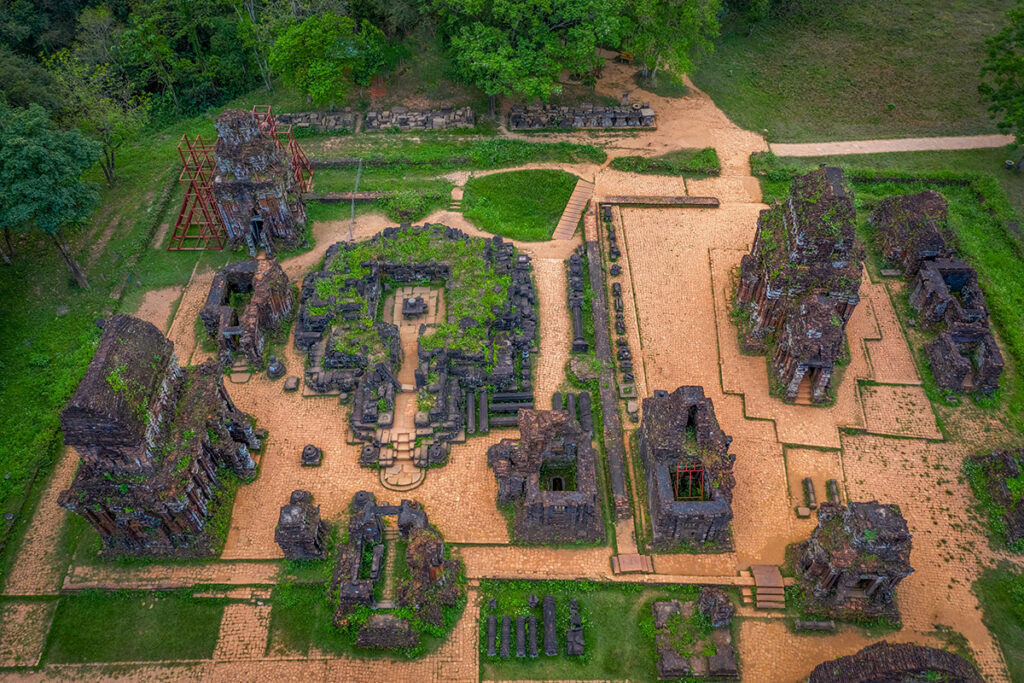
This is the heart of the sanctuary and the part that most visitors remember best. The temples in these groups date mainly from the 10th to 12th centuries, when the Cham Kingdom was at its cultural peak. The central shrine was dedicated to Shiva, and you can still see the square base where a linga-yoni altar once stood, symbolising creation and fertility.


The tall brick towers here are the most complete examples of Cham architecture. Notice how the bricks fit together seamlessly without mortar and how sandstone blocks were used for the doorways and decorative carvings. Some panels depict scenes from Hindu mythology, while others show flowers, priests, or animals. The largest tower in Group B was once the main sanctuary, surrounded by smaller buildings for offerings and ceremonies. Group D, slightly to the south, is partly ruined but gives a clear sense of how the temples were laid out in harmony with the surrounding hills.
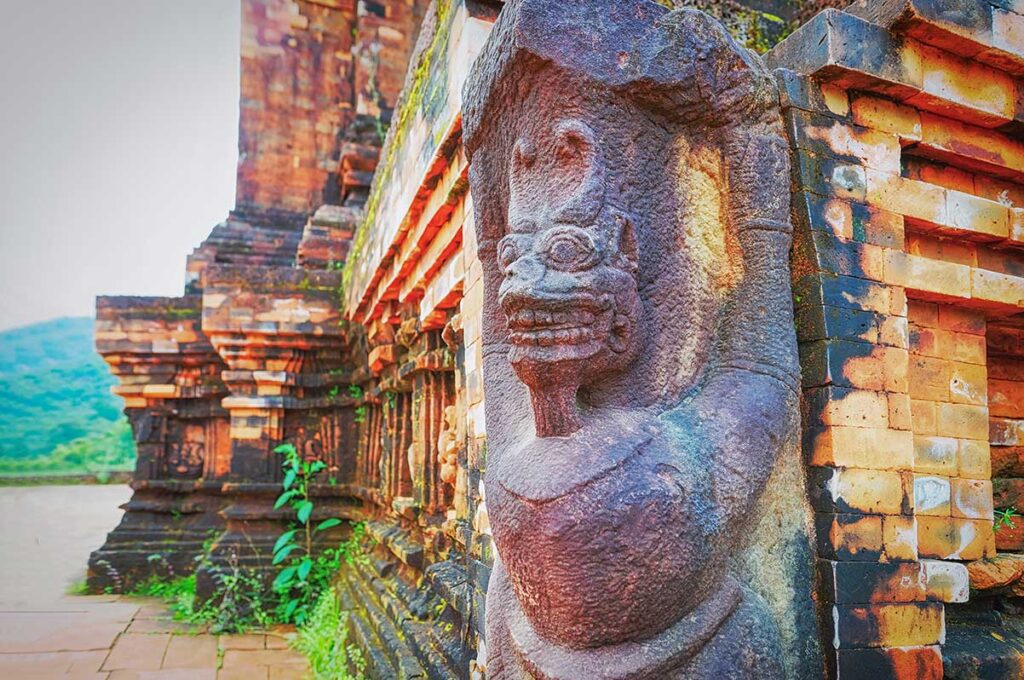

Even after centuries of decay and bomb damage, these structures retain an impressive sense of balance. The red bricks, darkened by time and humidity, glow softly against the green valley backdrop — a view that captures why My Son feels more spiritual than monumental.
2. The Early and Restored Area – Group A

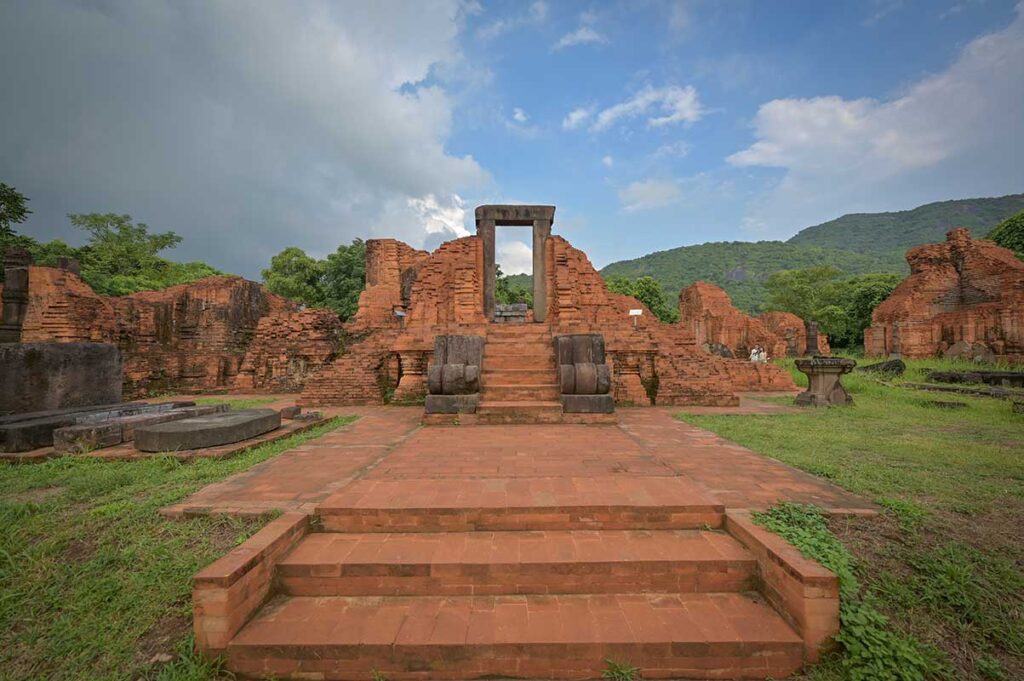
Group A lies near the entrance and contains some of the oldest remains at My Son, dating back as early as the 7th century. Much of it was destroyed during the war, but archaeologists have carefully stabilised the foundations and walls that survived.

This section is also home to a small site museum, where you can see sculptures, altar fragments and photos from early French expeditions. It’s worth a short stop before continuing into the main valley — the exhibits make it easier to recognise Cham patterns and religious symbols later on.
3. The outer and overgrown Sections – Groups E–F and G–H–L

As you move farther from the main core, the ruins become quieter and more overgrown. Groups E and F lie just beyond the central area and show a mix of partly collapsed walls and freestanding towers surrounded by trees. These were built slightly later, during a period when the Cham kingdom was declining, so the temples are simpler in style but atmospheric in their isolation.
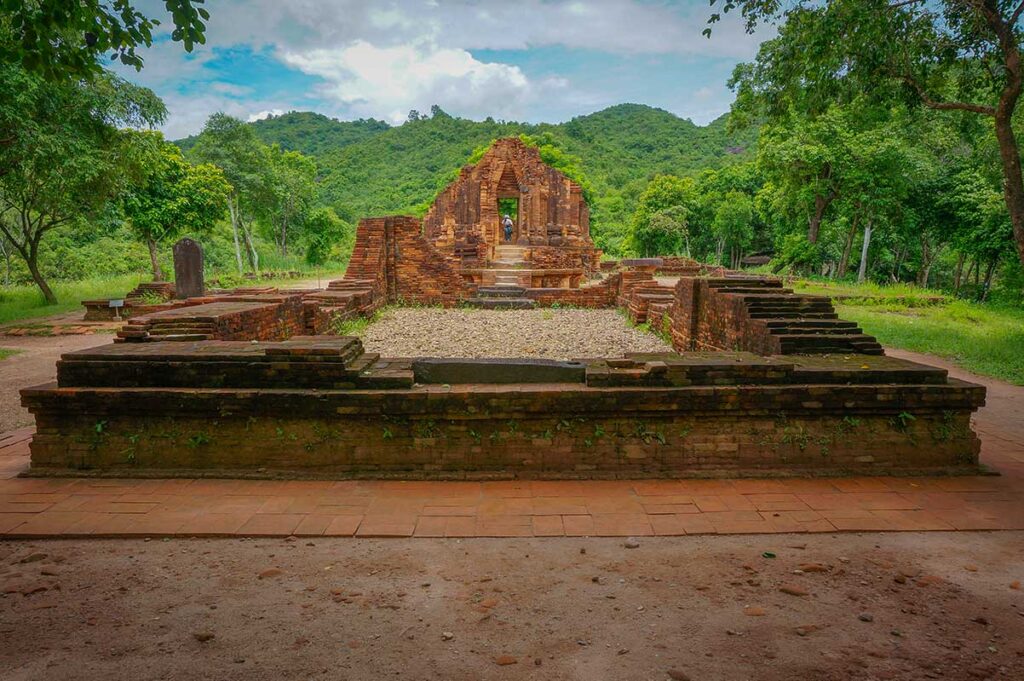
Beyond them, Groups G, H and L sit apart from the main path and are often missed by large tours. They’re smaller clusters — more like outlines of temples than standing buildings — but the moss-covered stones and faint outlines of towers give a real sense of discovery. This part of My Son feels closer to how the site must have looked when it was rediscovered in the early 1900s: quiet, half-buried, and reclaimed by nature.
4. Museum and Cultural performance
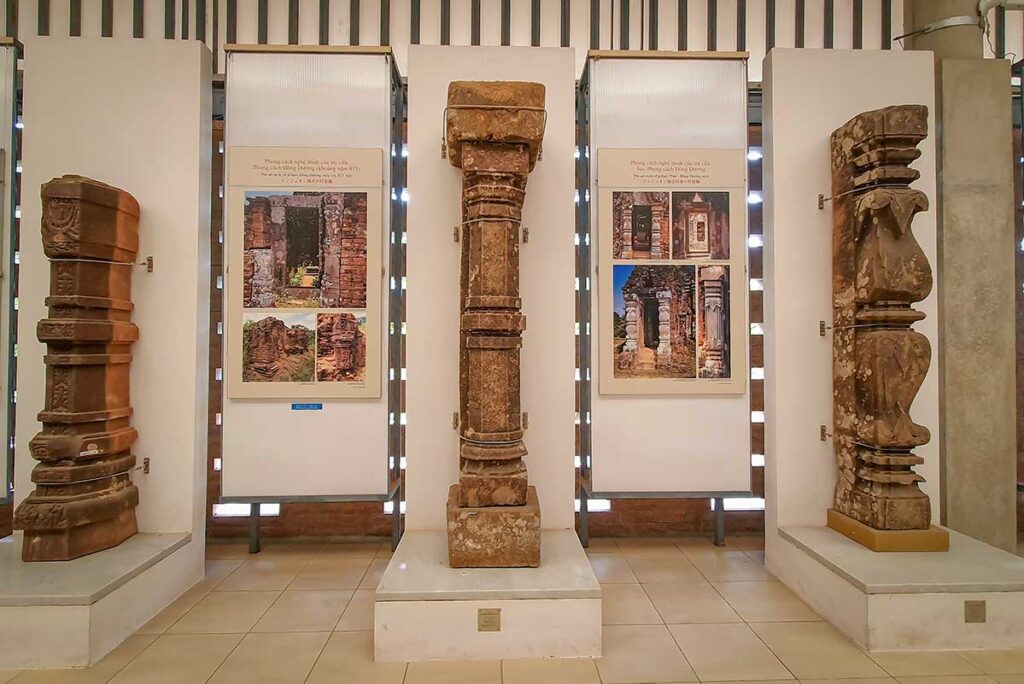
At the entrance, before boarding the electric shuttle to the ruins, you’ll find the Champa Museum, which displays statues and reliefs uncovered during excavations. Spending ten minutes here adds depth to the visit — you’ll start recognising the same motifs carved into the temple walls later on.
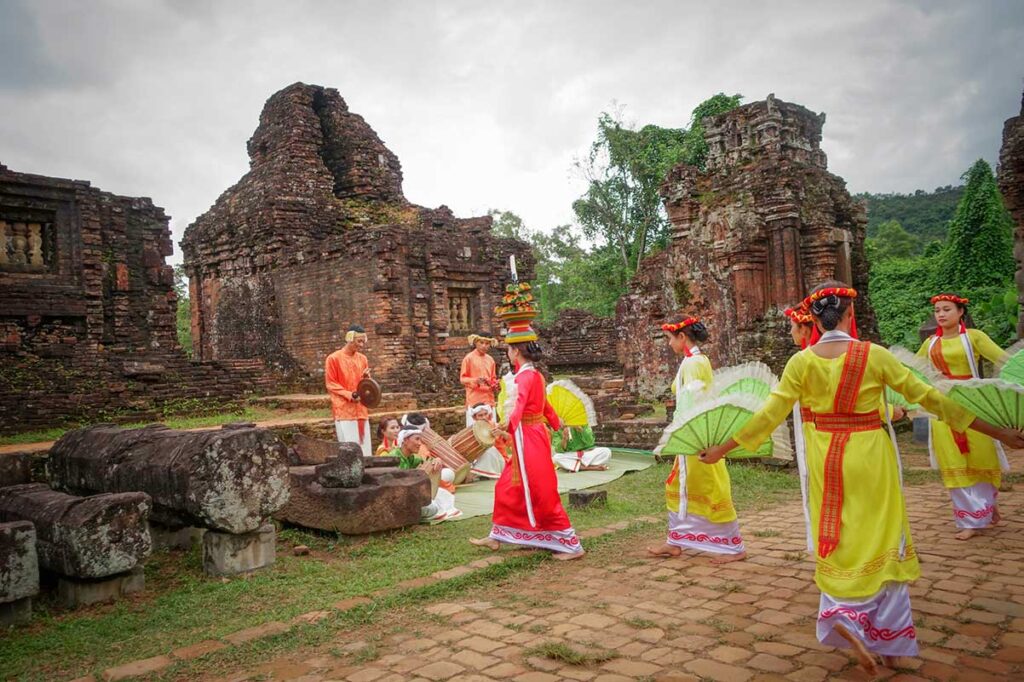
Nearby, there’s a small stage where short Cham dance performances are held a few times each day, usually in the morning. The dances are inspired by ancient temple rituals and performed in colourful traditional dress. It’s a brief but pleasant way to see how Cham culture lives on today, adding a human touch to a place otherwise defined by silent stone.
How to get there
Where is My Son Sanctuary?
My Son lies inland in Quang Nam Province, roughly 40 km from Hoi An and 65–70 km from Da Nang. The drive takes about one hour from Hoi An and around 90 minutes from Da Nang, depending on traffic. The final stretch follows a smaller country road through fields and small villages before you reach the entrance gate. The site sits in a low jungle valley surrounded by mountains, which means it can feel hotter and more humid than the coast. Early morning and late afternoon are the most comfortable times to visit.
Tours from Hoi An or Da Nang
Most visitors join a half-day tour from either Hoi An or Da Nang, as the distance is short and the roads are straightforward.
- Large group tours are the cheapest option, often including hotel pickup and a guide. They can be rushed and may not include the entrance ticket, so double-check before booking. Expect limited time at the ruins.
- Small group tours cost a bit more but allow better pacing, with guides who explain the Cham history in context. These usually leave early enough to avoid the heat and crowds. Small group tours often include a boat ride back to Hoi An on the Thu Bon River, stopping at a craft village such as Thanh Ha (pottery) or Kim Bong (carpentry). This makes the return journey more scenic and breaks up the drive nicely.
- Private tours or custom trips are the most flexible. They’re ideal if you want to start before sunrise or combine My Son with other stops.
My Son Sanctuary Tour from Hoi An (Small Group or Private)
- Experience Discover My Son’s ancient Cham temples with a local guide in a small group or private tour.
- Includes: Hotel pickup, lunch, and scenic boat cruise back to Hoi An.
You’ll also find a few specialty options:
- Dawn tours for early entry before large groups arrive.
- Motorbike tours where you ride pillion behind an experienced local driver (check our My Son tour by motorbike).
- Cycling tours that follow quiet backroads and finish with a van transfer back—great for the scenery, though it can be tiring in the heat.
DIY: Travel on your own
Visiting independently is simple and gives you full control of your timing.
- Car with driver – A private car from Hoi An is convenient and often cheaper than a metered taxi. Prices are fixed in advance, and while the driver won’t be a guide, you can stop for coffee or photos along the way.
- Motorbike or scooter – Renting a scooter in Hoi An costs around 100,000–150,000 VND per day. The route is mostly easy to follow, though traffic near town can be busy early in the morning. Officially, you need an international driving permit (IDP) to ride legally. Confident riders can also take the scenic alternative along the Thu Bon River, passing through rural villages and light traffic—a more relaxed drive than the main highway.
- Public or shuttle buses – A few shuttle buses run from Hoi An in the morning and return after lunch, but they’re infrequent and drop passengers near the main road rather than directly at the gate. These are fine for budget travelers but limit flexibility.
Parking, Tickets & Entry flow
When you arrive, you’ll first stop at the main visitor center, where you buy tickets (150,000 VND per person, including the museum and shuttle). From here, an electric cart or small shuttle bus takes you about 2 km into the valley to the start of the walking loop. The trail begins near Group C, where most people start exploring, and loops through the rest of the complex.
If you’re arriving by scooter or car, parking is available next to the ticket area for a small fee. It’s well organized, and from here you’ll find clear signs pointing toward the museum, shuttle, and the small stage for the Cham dance performance.
Practical visiting information & Travel tips
Visiting My Son is straightforward, but a few small details can make a big difference in how enjoyable the experience feels—especially given the heat, walking distance, and tour-group timing. Below is everything you need to know to plan a smooth and comfortable visit.
Tickets & Opening Hours
The sanctuary is open daily from 6:30 a.m. to 5:30 p.m. Tickets cost 150,000 VND per person and include entry to the main site, the Champa Museum, and the electric shuttle that runs between the ticket gate and the ruins. When running, the Cham dance show near the entrance is also included in this ticket price—no extra payment required.
Best Time to Visit (Heat & Crowds)
The most pleasant time to visit is around 7:00 a.m., when temperatures are still mild and tour buses haven’t arrived yet. The air in the valley warms up quickly after 9:00 a.m., and by late morning, the heat can be draining. Late afternoon is a quieter alternative, though it’s often humid and there’s a chance of short rain showers, especially from September to December.
The dry season (February–August) offers the most reliable weather, while the rainy season (September–January) brings greener scenery but occasional showers. If you go in the afternoon during the wet months, bring a light rain jacket—sudden tropical downpours are common.
What to wear & Etiquette
There’s no strict dress code, but this is a historical and religious site, so dressing modestly shows respect. Covering shoulders and knees is appreciated, though not enforced. Avoid climbing on the structures or touching carvings. Drones are officially restricted unless you have special permission, and some areas under restoration may be fenced off—follow signs and pathways.
What to bring
Bring water, a hat, and sunscreen, as parts of the trail are open to direct sunlight. Wear lightweight clothing and comfortable shoes for walking on uneven stone and dirt paths. A small towel or portable fan helps in the humid valley climate. Carry some cash for snacks or drinks—there are a few local stalls and a café near the entrance, but no ATMs or card payment options inside.
Facilities, food & nearby cafes
There are clean toilets near the entrance and another set close to the shuttle stop inside the site. A small café and several drink stalls sell coconuts, water, and snacks. Most of the route is outdoors, with only limited shade—there are some covered rest areas near major temple groups where you can sit for a moment. The museum is air-conditioned and a good place to cool down briefly.
Time needed & Walking distance
Plan at least two hours for a comfortable visit. The walking loop is about 4 km, starting from where the shuttle drops you off near Group C. If you’re short on time, it’s possible to see the main temple clusters in about 90 minutes, but taking longer allows you to explore side paths and quieter sections. Walking counter-clockwise is often less crowded, as most organized tours move in the opposite direction.
Accessibility notes
The electric shuttle from the ticket area saves a 2 km uphill walk to the ruins. Within the site, paths are mostly flat but uneven, with steps in and around the temple clusters. Wheelchairs and strollers can manage part of the route but not the entire loop. If mobility is limited, focus on Groups B–C–D, where the temples are closest together and easiest to reach.
Safety & Weather
The bricks and paths can become slippery after rain, especially around shaded mossy areas. Wear shoes with good grip and walk carefully on the raised platforms. In the afternoon, short but intense thunderstorms are common; seek shelter in the museum or café if one passes through—it usually clears within 15–20 minutes. Avoid touching loose stones or entering fenced-off areas under restoration.
Guided vs Self-Guided
A guide adds real value if you want to understand the religious symbolism, carvings, and layout of the temples. Guided tours are usually short but informative and available in several languages. If you prefer to explore at your own pace, the information signs in English are clear and sufficient for most visitors. Some people use audio guides or apps, but the site’s atmosphere often speaks for itself—you don’t need commentary to enjoy it.
Map & Wayfinding
You can pick up a printed map at the ticket counter or take a photo of the large map board near the entrance before boarding the shuttle. The main loop is easy to follow, with clear English signboards marking each temple group. Paths are well maintained, and even without a guide, it’s hard to get lost. For a quieter experience, walking counter-clockwise lets you move against the flow of large tour groups that start from the opposite end.
Tip: Cham Museum in Da Nang
If you want to deepen what you saw at My Son, the Cham Museum in Da Nang has the best collection of Cham sculptures and reliefs from the region. It’s a straightforward add-on if you’re coming from/returning to Da Nang the same day.
What to combine it with
There isn’t much right next to My Son — it’s a remote valley — so combinations usually happen on the way back toward Hoi An rather than “nearby.”

Some small-group or private tours add a river leg on the Thu Bon with a stop at a craft village (carpentry or pottery), which simply makes the return more pleasant. If you’re riding a motorbike, you can also follow quieter village roads along the Thu Bon for scenery, but there aren’t standout sights to detour for; most worthwhile stops are closer to Hoi An than to My Son.
Is My Son Sanctuary worth it?
If you’re expecting something on the scale of Angkor Wat, My Son will feel small. But if you appreciate history, atmosphere, and quiet settings, it’s absolutely worth a visit. The ruined towers, jungle backdrop, and sense of age make it a place to experience slowly rather than to rush through for photos.
You’ll enjoy My Son most if you value cultural sites with character over grandeur—the kind of place where you can wander, imagine its past, and enjoy the calm before the heat or crowds arrive. It’s less ideal if you have little patience for humidity, limited shade, or smaller-scale ruins. In short: go for the ambience and story, not the size, and you’ll come away glad you made the trip.
